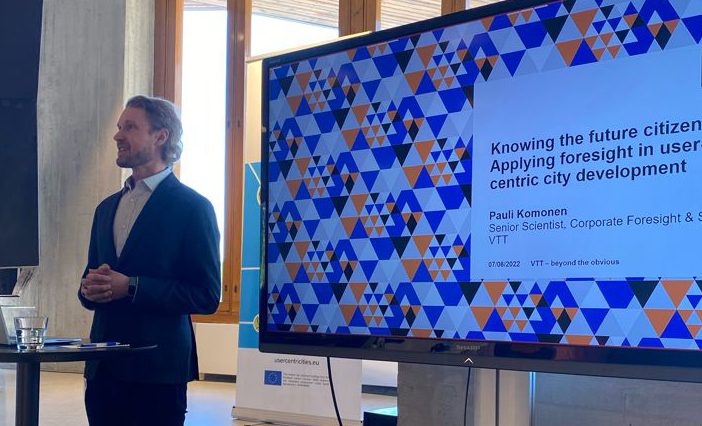
UserCentriCities convened the third edition of the peer-to-peer workshops series. A hybrid event where cities and regions had the chance to discuss recent changes in technologies and policies and how we can predict and match the expectations of citizens to develop better tailored digital services.
Pauli Komonen, senior scientist for corporate strategy and foresight at VTT Technical Research Centre of Finland delivered a keynote speech on “Knowing the future citizen: applying foresight in user-centric city development”, where he explained how city policymakers can use foresight methodologies to navigate uncertainties and shape desired futures.
According to the European Commission’s definition, strategic foresight is not about predicting the future, but exploring different possible futures alongside the opportunities and challenges it might present. Considering the plans, desires, and expectations of citizens about their futures is crucial to help us act in the present and help design the future we want. But how can we combine human perspective with strategic foresight?
VTT’s future radar for detecting sustainable trends in smart cities tool is one of the methods that can help identify opportunities and risks. For example, virtual and augmented living technologies have the potential to play a key role in cities as a tool for reaching various smart city targets, including sustainability. Another opportunity trend is smart assisted living for the ageing population. It is expected that by 2030 more than a billion people will be over 65 years old. Technologically innovative solutions such as digital monitoring, protection and support for elderly people in their daily lives present an opportunity to tackle one of the biggest challenges for the future.
Some recommendations presented for using strategic foresight in user-centric city development are:
1) Identify the lead users of your city, those who adopt new behaviours first. Co-develop solutions with them and understand their perspective.
2) Build a systematic and continuous foresight model for detecting signals, trends and risks related to cities.
3) Bring together a broad range of stakeholders in networked foresight work.
4) Communicate the results in an engaging way, both internally and externally.
5) Ensure that the foresight work contributes to decision-making by creating a relevant, plausible and strategic forward-looking view.
The keynote was followed by the results of a previous workshop carried out by the city of Espoo on the digital services of the future with young citizens. The workshop aimed to better understand what services young people use, how they rate them, and their expectations for future services. Veera Vihula, project manager at the City of Espoo, presented the main findings.
What makes a service good or bad? For young people, it is mainly focused on its purpose and usability. For example, good services are both usable on a web browser and mobile, and most importantly must be free of charge.
In regard to data and security, most young people don’t stop to think about when accepting cookies or terms and conditions when browsing or signing up for a new service, but there is a concern about where this data goes and for what other purposes can it be used.
Lastly, when asked how future services should be designed, the main findings were getting rid of passwords and coming up with a new way to log in securely, followed by better web design to have all information on one single page and avoid linking from one landing page to another. A lot of importance was also given to having free good working connection available anywhere in their city. Finally, it was suggested that there should be more information on the services that are available and what their purpose is. Making the service easy to use is the ultimate goal, or there won’t be any motivation for people to use it.
Download Pauli Komonen's Presentation